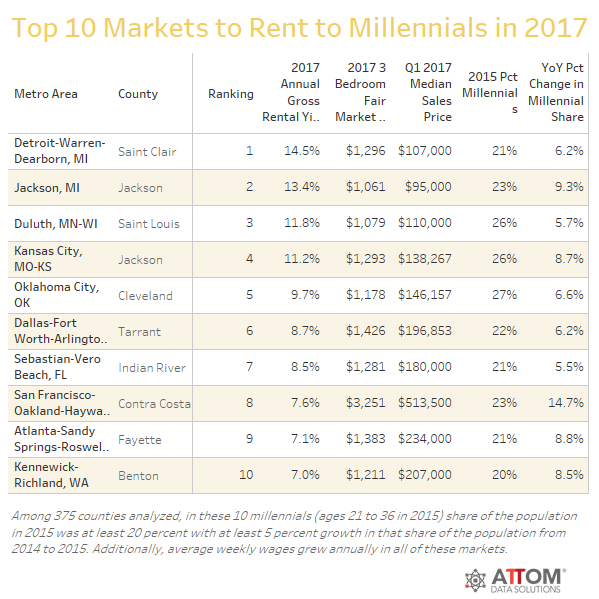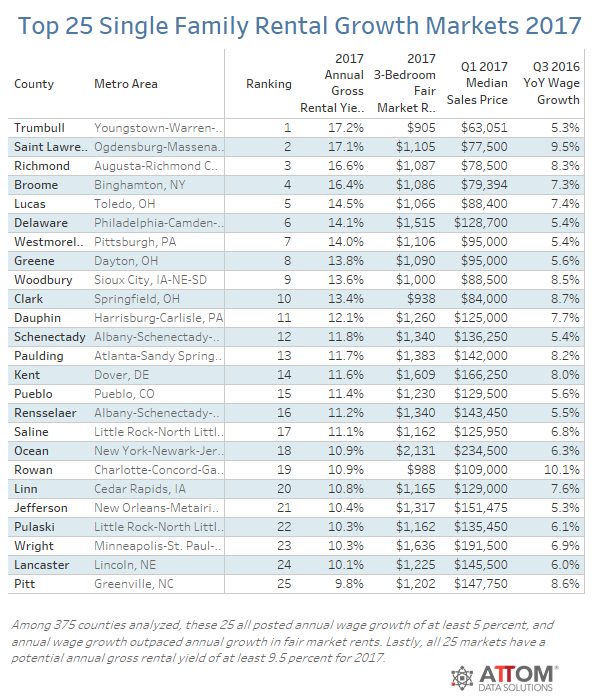The WPJ
THE WORLD PROPERTY JOURNALReal Estate Facts Not Fiction
Residential Real Estate News

Best U.S. Markets for Buying Single Family Rental Homes in 2017 Revealed
Residential News » Irvine Edition | By WPJ Staff | March 28, 2017 8:00 AM ET
ATTOM Data Solutions has just released its Q1 2017 Single Family Rental Market Report, which ranks the best U.S. markets for buying single-family rental properties in 2017.
According to their study, the average annual gross rental yield (annualized gross rent income divided by median purchase price of single family homes) among the 375 counties was 9.0 percent for 2017, down from an average of 9.1 percent in 2016.
"While good returns on single family rentals are hard to come by in high-priced coastal markets and in some other housing hot spots such as Denver and parts of Dallas, Austin and Nashville, solid returns on single family rentals will continue to be available in many parts of the Southeast, Rust Belt and Midwest for investors purchasing in 2017," said Daren Blomquist, senior vice president at ATTOM Data Solutions. "And single family rentals should continue to yield strong returns in many parts of the country going forward given the market undercurrents of low rent-ready housing inventory and low homeownership rates. Average fair market rents increased in 2017 in 86 percent of the markets we analyzed even while average wage growth outpaced rent growth in 67 percent of markets -- a recipe for sustainable growth in the rental market."
Counties with the highest annual gross rental yields were Clayton County, Georgia, in the Atlanta metro area (23.7 percent); Baltimore City, Maryland (23.6 percent); Bibb County, Georgia, in the Macon metro area (23.5 percent); Monroe County, Pennsylvania, in the East Stroudsburg metro area (20.6 percent); and Saginaw County, Michigan (18.8 percent).
Among 40 counties with a population of at least 1 million people, those with the highest gross rental yields were Wayne County, Michigan, in the Detroit metro area (17.3 percent); Cuyahoga County, Ohio in the Cleveland metro area (13.2 percent); Allegheny County, Pennsylvania, in the Pittsburgh metro area (10.6 percent); Philadelphia County, Pennsylvania (10.1 percent); and Franklin County, Ohio in the Columbus metro area (9.9 percent).
Counties with lowest single-family rental returns
Counties with the lowest annual gross rental yields were Arlington County, Virginia, in the Washington, D.C., metro area (3.4 percent); Williamson County, Tennessee, in the Nashville metro area (3.9 percent); Santa Cruz County, California (4.1 percent); Norfolk County, Massachusetts, in the Boston metro area (4.2 percent); and Santa Clara County, California, in the San Jose metro area (4.2 percent).
Along with Santa Clara County, the lowest gross annual rental yields for counties with a population of at least 1 million were in Kings County (Brooklyn), New York (4.4 percent); Orange County, California, south of Los Angeles (4.6 percent); Fairfax County, Virginia, in the Washington, D.C., metro area (4.6 percent); and Queens County, New York (4.7 percent).
Rental yields decrease in 57 percent of markets
Median sales prices for single family homes rose faster than average fair market rents in 213 of the 375 counties (57 percent), resulting in declining gross annual rental yields in the same percentage of counties.
Counties with the declining gross annual rental yields included Los Angeles County, California; Cook County, Illinois, in the Chicago metro area; Maricopa County, Arizona in the Phoenix metro area; Miami-Dade County, Florida; and Queens County, New York.
"Unlike their apartment counterparts, single-family home rental rates in the greater Seattle area have leveled off significantly," said Matthew Gardner, chief economist at Windermere Real Estate, covering the Seattle market, where in King County the annual gross rental yield in 2017 is down from 2016 thanks to median home prices increasing 5 percent compared to a 1 percent increase in average fair market rents. "While home prices in this area continue to see steep increases, rents have not followed suit. I believe this is because the incomes of those who rent single-family homes are not keeping pace with rising home prices, so rents have had to adjust to the realities of the market.
"Single-family home rental rates will likely continue to see very modest increases, as many of these renters are converting to buyers," Gardner continued. "In fact, 'Boomerang Buyers', who were forced to become renters when they lost their homes to foreclosure, are now in a position to qualify for a mortgage again. This process could lead to declining demand for single-family rentals, forcing landlords to adjust their rents accordingly in order to keep their properties occupied."
The report identified and ranked 25 counties with the best potential for future growth in returns on single-family rentals. In all 25 counties, average weekly wages increased at least 5 percent annually and outpaced growth in fair market rents. All 25 counties also had gross annual yields of 9.5 percent or higher.
The top five counties for single family rental growth were Trumbull County, Ohio, in the Youngstown metro area (17.2 percent); Saint Lawrence County, New York, in the Ogdensburg-Massena metro area (17.1 percent gross annual rental yield); Richmond County, Georgia, in the Augusta metro area (16.6 percent); Broome County, New York, in the Binghamton metro area (16.4 percent); and Lucas County, Ohio, in the Toledo metro area (14.5 percent).
The report also identified and ranked the 10 best counties for renting single-family homes to millennials. In all 10 counties, the millennial share of the population increased at least 5 percent between 2014 and 2015 -- the most recent data available from the Census Bureau -- and millennials accounted for at least 20 percent of the total population in 2015. All 10 counties also posted annual wage growth. For purposes of the report, millennials were defined as anyone born between 1979 and 1994, limiting it to millennials at least 20 years old in 2014 and likely to be potential homebuyers.
Sorted by annual gross rental yield, the top five millennial single family rental markets were Saint Clair County, Michigan, in the Detroit metro area (14.5 percent gross annual rental yield); Jackson County, Michigan (13.4 percent); Saint Louis County, Minnesota, in the Duluth metro area (11.8 percent); Jackson County, Missouri, in the Kansas City metro area (11.2 percent); and Cleveland County, Oklahoma, in the Oklahoma City metro area (9.7 percent).
The top five zip codes with the highest potential single family rental returns for 2017 were 43605 in Toledo, Ohio (119.4 percent); 63115 in St. Louis (90.4 percent); 21223 in Baltimore (87.2 percent); 08104 in Camden, New Jersey (86.3 percent); and 35208 in Birmingham, Alabama (78.4 percent).
The five zip codes with the lowest potential single family rental returns for 2017 were 33480 in Palm Beach, Florida (0.7 percent); 90210 in Beverly Hills, California (0.8 percent); 90402 in Santa Monica, California (0.8 percent); 90049 in Los Angeles, California (1.1 percent); and 90272 in Pacific Palisades, California (1.2 percent).


Sign Up Free | The WPJ Weekly Newsletter
Relevant real estate news.
Actionable market intelligence.
Right to your inbox every week.
Real Estate Listings Showcase
Related News Stories
Residential Real Estate Headlines
- More Americans Opting for Renting Over Homeownership in 2024
- BLOCKTITLE Global Property Tokenization Platform Announced
- Small Investors Quietly Reshaping the U.S. Housing Market in Late 2024
- Greater Miami Overall Residential Sales Dip 9 Percent in November
- U.S. Home Sales Enjoy Largest Annual Increase in 3 Years Post Presidential Election
- U.S. Housing Industry Reacts to the Federal Reserve's Late 2024 Rate Cut
- U.S. Home Builders Express Optimism for 2025
- Older Americans More Likely to Buy Disaster-Prone Homes
- NAR's 10 Top U.S. Housing Markets for 2025 Revealed
- U.S. Mortgage Delinquencies Continue to Rise in September
- U.S. Mortgage Rates Tick Down in Early December
- Post Trump Election, U.S. Homebuyer Sentiment Hits 3-Year High in November
- Global Listings Aims to Become the Future 'Amazon of Real Estate' Shopping Platform
- Greater Las Vegas Home Sales Jump 15 Percent in November
- Ultra Luxury Home Sales Globally Experience Slowdown in Q3
- World Property Exchange Announces Development Plan
- Hong Kong Housing Market to Reach Equilibrium in Late 2025
- Construction Job Openings in U.S. Down 40 Percent Annually in October
- U.S. Mortgage Applications Increase in Late October
- World Property Markets, World Property Media to Commence Industry Joint-Venture Funding Rounds in 2025
- New Home Sales Hit 2 Year Low in America
- U.S. Pending Home Sales Increase for Third Consecutive Month in October
- Pandemic-led Residential Rent Boom is Now Fizzling in the U.S.
- Emerging Global Real Estate Streamer WPC TV Expands Video Programming Lineup
- 1 in 5 Renters in America Entire Paycheck Used to Pay Monthly Rent in 2024
- U.S. Home Sales Jump 3.4 Percent in October
- Home Buyers Negotiation Power Grows Amid Cooling U.S. Market
- Canadian Home Sales Surge in October, Reaching a Two-Year High
- Greater Orlando Area Home Sales Continue to Slide in October
- U.S. Mortgage Credit Availability Increased in October
- U.S. Mortgage Rates Remain Stubbornly High Post Election, Rate Cuts
- Construction Input Prices Continue to Rise in October
- BETTER MLS: A New Agent and Broker Owned National Listings Platform Announced
- Home Prices Rise in 87 Percent of U.S. Metros in Q3
- Caribbean Islands Enjoying a New Era of Luxury Property Developments
- The World's First 'Global Listings Service' Announced
- Agent Commission Rates Continue to Slip Post NAR Settlement
- Market Share of First Time Home Buyers Hit Historic Low in U.S.
- Greater Palm Beach Area Residential Sales Drop 20 Percent Annually in September
- Mortgage Applications in U.S. Dip in Late October
Reader Poll
Marketplace Links
This website uses cookies to improve user experience. By using our website you consent in accordance with our Cookie Policy. Read More





